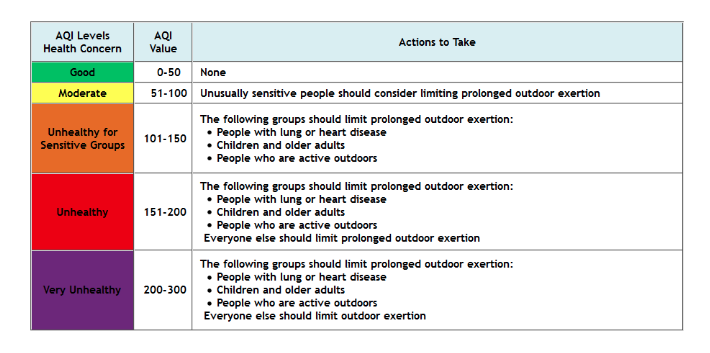By Hank Black
Ambient air quality in Jefferson County is forecast daily year-round for fine particulate matter and during the warm season for ozone.
The EPA has set National Ambient Air Quality Standards for six common, regularly monitored air pollutants considered harmful to public health and the environment.
A color-coded Air Quality Index is used to communicate the current level of pollution to the public. These are the six monitored pollutants:
- Nitrogen dioxide (NO2)
- Ozone (O3)
- Sulfur dioxide (SO2)
- Coarse and fine particulate matter (PM)
- Carbon monoxide (CO)
- Lead (Pb)
Four of them (CO, Pb, SO2, NO2) are emitted directly from several sources. Ozone is formed not by direct emission, but when oxides of nitrogen and volatile organic compounds react with sunlight. PM can be an emission, or it can result from a reaction from nitrogen oxides, sulfur oxides, ammonia, organic compounds and other gases in the atmosphere.
Forecasts and air quality notifications are available without charge:
- Online at jcdh.org and www.airnow.gov
- By phone at 205-933-0583
- On Twitter @JCDH_AirQuality
- Email or text: sign up at http://birmingham.enviroflash.info/
When air pollution is high enough, an Air Quality Alert is issued, warning people to minimize time spent outdoors. Especially vulnerable are the very young and old, pregnant women and those with heart, respiratory, or immune system impairments. In addition, everyone is asked to take measures to lower emissions, such as by driving less.
Particularly Harmful Pollutants Include:
Ground-level ozone, popularly called smog, is most apparent in the hot months with plenty of sunshine. It occurs when nitrogen oxides and volatile organic compounds react with heat and sunlight. Nitrogen oxides are emitted primarily from motor vehicles (especially diesel) and power generation from coal-burning plants. Gas-powered lawn maintenance equipment also contributes. Volatile organic compounds are emissions from gas stations, dry cleaners, paint shops and gasoline-powered engines of all kinds. Some also are naturally produced by trees, especially pine trees.
Particulate matter, or particle pollution, comes from power plants, factories and motor vehicles as well as wood burning and agricultural and construction work. It occurs throughout the year, not only in summer months. Of greatest concern is particulate matter small enough to travel far into lung tissue and even the bloodstream.
JeffCo Monitoring Station Locations:
- North Birmingham NCore – 3009 28th North
- Fairfield – 5229 Court B
- McAdory – 4800 McAdory School Road
- Leeds – 201 Ashville Road
- Corner – 1005 Corner School Road
- Tarrant – 1269 Portland St.
- Shuttlesworth – 4113 Shuttlesworth Drive.
- Arkadelphia (near road) – 1110 5th St. West.
- Wylam – 1242 Jersey St.
- Hoover – 3425 Tamassee Lane*
Air quality data in near-real time from across the Birmingham area can be found in a graphic display at www.nsstc.uah.edu/bhamaq/current.html.
*The Jefferson County Department of Health has proposed shutting down the Hoover monitoring station, which measures only ozone levels, because that area of south Jefferson County is covered by a nearby site in Helena.
What You Can Do
In Jefferson County, almost as much air pollution is caused by motor vehicle traffic as by stationary sources, according to the county Health Department.
“Over past decades, industry and the community have worked together under regulations and with better technology to decrease pollution, yet we are in the top five in the nation in our use of single-occupancy vehicles,” said meteorologist Matt Lacke.
Cars and trucks are not regulated except by federal emissions standards.
The Regional Planning Commission of Greater Birmingham encourages better control of vehicular emissions by offering free testing at Express Oil Lube locations on designated days and may pay for repairs to emission systems.
Greater use of ride-sharing programs, car pools and public transit could help clean our skies, Lacke said, “but are not universally utilized.”
When Air Quality Alerts are issued, people are encouraged to reduce driving in gasoline-powered vehicles. For healthy individuals, walking and biking are alternatives to gasoline engines, as are electric or hybrid vehicles.
Other solutions suggested by the health department include:
- Roll errands into one trip instead of multiple trips.
- Limit engine idling and avoid drive-through lines.
- Don’t use gas-powered lawn or garden equipment.
- Pump gas after dusk.
Complaint Line: Anyone can report suspected unauthorized air pollution by calling 205-930-1276.

